1.4: Addition of Whole Numbers
- Page ID
- 48777
Learning Objectives
- understand the addition process
- be able to add whole numbers
- be able to use the calculator to add one whole number to another
Addition
Suppose we have two collections of objects that we combine together to form a third collection. For example,

We are combining a collection of four objects with a collection of three objects to obtain a collection of seven objects.
Definition: Addition
The process of combining two or more objects (real or intuitive) to form a third, the total, is called addition.
In addition, the numbers being added are called addends or terms, and the total is called the sum. The plus symbol (+) is used to indicate addition, and the equal symbol (=) is used to represent the word "equal." For example, 4 + 3 = 7 means "four added to three equals seven."
Addition Visualized on the Number Line
Addition is easily visualized on the number line. Let's visualize the addition of 4 and 3 using the number line.
To find 4 + 3
- Start at 0.
- Move to the right 4 units. We are now located at 4.
- From 4, move to the right 3 units. We are now located at 7.
Thus, 4 + 3 = 7

The Addition Process
We'll study the process of addition by considering the sum of 25 and 43.


We write this as 68.
We can suggest the following procedure for adding whole numbers using this example.
The Process of Adding Whole Numbers
To add whole numbers,
The process:
- Write the numbers vertically, placing corresponding positions in the same column.
\(\begin{array} {r} {25} \\ {\underline{+43}} \end{array}\) - Add the digits in each column. Start at the right (in the ones position) and move to the left, placing the sum at the bottom.
\(\begin{array} {r} {25} \\ {\underline{+43}} \\ {68} \end{array}\)
Caution
Confusion and incorrect sums can occur when the numbers are not aligned in columns properly. Avoid writing such additions as
\(\begin{array} {l} {25} \\ {\underline{+43}} \end{array}\)
\(\begin{array} {r} {25} \\ {\underline{+43\ \ }} \end{array}\)
Sample Set A
Add 276 and 103.
Solution
\(\begin{array} {r} {276} \\ {\underline{+103}} \\ {379} \end{array}\) \(\begin{array} {r} {6 + 3 = 9.} \\ {7 + 0 = 7.} \\ {2 + 1 = 3.} \end{array}\)
Sample Set A
Add 1459 and 130
Solution
\(\begin{array} {r} {1459} \\ {\underline{+130}} \\ {1589} \end{array}\) \(\begin{array} {r} {9 + 0 = 9.} \\ {5 + 3 = 8.} \\ {4 + 1 = 5.} \\ {1 + 0 = 1.} \end{array}\)
In each of these examples, each individual sum does not exceed 9. We will examine individual sums that exceed 9 in the next section.
Practice Set A
Perform each addition. Show the expanded form in problems 1 and 2.
Add 63 and 25.
- Answer
-
88

Practice Set A
Add 4,026 and 1,501.
- Answer
-
5,527

Practice Set A
Add 231,045 and 36,121.
- Answer
-
267,166
Addition Involving Carrying
It often happens in addition that the sum of the digits in a column will exceed 9. This happens when we add 18 and 34. We show this in expanded form as follows.
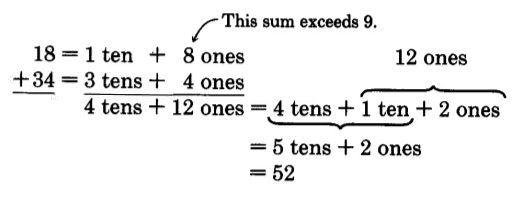
Notice that when we add the 8 ones to the 4 ones we get 12 ones. We then convert the 12 ones to 1 ten and 2 ones. In vertical addition, we show this conversion by carrying the ten to the tens column. We write a 1 at the top of the tens column to indicate the carry. This same example is shown in a shorter form as follows:

8 + 4 = 12 Write 2, carry 1 ten to the top of the next column to the left.
Sample Set B
Perform the following additions. Use the process of carrying when needed.
Add 1875 and 358.
Solution
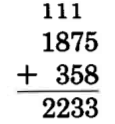
\(\begin{array} {lcl} {5 + 8 = 13} & \ \ & {\text{Write 3, carry 1 ten.}} \\ {1 + 7 + 5 = 13} & \ \ & {\text{Write 3, carry 1 hundred.}} \\ {1 + 8 + 3 = 12} & \ \ & {\text{Write 2, carry 1 thousand.}} \\ {1 + 1 = 2} & \ \ & {} \end{array}\)
The sum is 2233.
Sample Set B
Add 89,208 and 4,946.
Solution
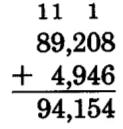
\(\begin{array} {lcl} {8 + 6 = 14} & \ \ & {\text{Write 4, carry 1 ten.}} \\ {1 + 0 + 4 = 5} & \ \ & {\text{Write the 5 (nothing to carry).}} \\ {2 + 9 = 11} & \ \ & {\text{Write 1, carry one thousand.}} \\ {1 + 9 + 4 = 14} & \ \ & {\text{Write 4, carry one ten thousand}.} \\ {1 + 8 = 9} & \ \ & {} \end{array}\)
The sum is 94,154.
Sample Set B
Add 38 and 95.
Solution
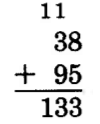
\(\begin{array} {lcl} {8 + 5 = 13} & \ \ & {\text{Write 3, carry 1 ten.}} \\ {1 + 3 + 9 = 13} & \ \ & {\text{Write 3, carry 1 hundred.}} \\ {1 + 0 = 1} & \ \ & {} \end{array}\)
As you proceed with the addition, it is a good idea to keep in mind what is actually happening.

The sum is 133.
Sample Set B
Find the sum 2648, 1359, and 861.
Solution
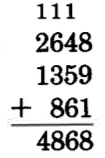
\(\begin{array} {lcl} {8 + 9 + 1 = 18} & \ \ & {\text{Write 8, carry 1 ten.}} \\ {1 + 4 + 5 + 6 = 16} & \ \ & {\text{Write 6, carry 1 hundred.}} \\ {1 + 6 + 3 + 8 = 18} & \ \ & {\text{Write 8, carry 1 thousand.}} \\ {1 + 2 + 1 = 4} & \ \ & {} \end{array}\)
The sum is 4,868.
Numbers other than 1 can be carried as illustrated in next example.
Sample Set B
Find the sum of the following numbers.
Solution
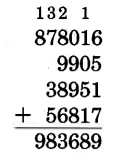
\(\begin{array} {lcl} {6 + 5 + 1 + 7 = 19} & \ \ & {\text{Write 9, carry the 1.}} \\ {1 + 1 + 0 + 5 + 1 = 8} & \ \ & {\text{Write 8.}} \\ {0 + 9 + 9 + 8 = 26} & \ \ & {\text{Write 6, carry the 2.}} \\ {2 + 8 + 9 + 8 + 6 = 33} & \ \ & {\text{Write 3, carry the 3}.} \\ {3 + 7 + 3 + 5 = 18} & \ \ & {\text{Write 8, carry the 1.}} \\ {1 + 8 = 9} & \ \ & {\text{Write 9.}} \end{array}\)
The sum is 983,689.
Sample Set B
The number of students enrolled at Riemann College in the years 1984, 1985, 1986, and 1987 was 10,406, 9,289, 10,108, and 11,412, respectively. What was the total number of students enrolled at Riemann College in the years 1985, 1986, and 1987?
Solution
We can determine the total number of students enrolled by adding 9,289, 10,108, and 11,412, the number of students enrolled in the years 1985, 1986, and 1987.

The total number of students enrolled at Riemann College in the years 1985, 1986, and 1987 was 30,809.
Practice Set B
Perform each addition. For the next three problems, show the expanded form.
Add 58 and 29.
- Answer
-
87

-
\(\begin{array} {l} {\text{= 7 tens + 1 ten + 7 ones}} \\ {\text{= 8 tens + 7 ones}} \\ {\text{= 87}} \end{array}\)
Practice Set B
Add 476 and 85.
- Answer
-
561

\(\begin{array} {r} {\text{= 4 hundreds + 15 tens + 1 ten + 1 one}} \\ {\text{= 4 hundreds + 16 tens + 1 one}} \\ {\text{= 4 hundreds + 1 hundred + 6 tens + 1 one}} \\ {\text{= 5 hundreds + 6 tens + 1 one}} \\ {\text{= 561}} \end{array}\)
Practice Set B
Add 27 and 88.
- Answer
-
115

\(\begin{array} {l} {\text{= 10 tens + 1 ten + 5 ones}} \\ {\text{= 11 tens + 5 ones}} \\ {\text{= 11 hundred + 1 ten + 5 ones}} \\ {\text{= 115}} \end{array}\)
Practice Set B
Add 67,898 and 85,627.
- Answer
-
153,525
For the next three problems, find the sums.
Practice Set B
\(\begin{array} {r} {57} \\ {26} \\ {\underline{\ \ 84}} \end{array}\)
- Answer
-
167
Practice Set B
\(\begin{array} {r} {847} \\ {825} \\ {\underline{\ \ 796}} \end{array}\)
- Answer
-
2,468
Practice Set B
\(\begin{array} {r} {16,945} \\ {8,472} \\ {387,721} \\ {21,059} \\ {\underline{\ \ \ \ \ \ \ \ 629}} \end{array}\)
- Answer
-
434,826
Calculators
Calculators provide a very simple and quick way to find sums of whole numbers. For the two problems in Sample Set C, assume the use of a calculator that does not require the use of an ENTER key (such as many Hewlett-Packard calculators).
Sample Set C
Use a calculator to find each sum.
| 34 + 21 | Display Reads | |
| Type | 34 | 34 |
| Press | + | 34 |
| Type | 21 | 21 |
| Press | = | 55 |
Solution
The sum is 55.
Sample Set C
| 106 + 85 + 322 + 406 | Display Reads | ||
| Type | 106 | 106 | The calculator keeps a running subtotal |
| Press | + | 106 | |
| Type | 85 | 85 | |
| Press | = | 191 | \(\leftarrow\) 106 + 85 |
| Type | 322 | 322 | |
| Press | + | 513 | \(\leftarrow\) 191 + 322 |
| Type | 406 | 406 | |
| Press | = | 919 | \(\leftarrow\) 513 + 406 |
- Answer
-
The sum is 919.
Practice Set C
Use a calculator to find the following sums.
62 + 81 + 12
- Answer
-
155
Practice Set C
9,261 + 8,543 + 884 + 1,062
- Answer
-
19,750
Practice Set C
10,221 + 9,016 + 11,445
- Answer
-
30,682
Exercises
For the following problems, perform the additions. If you can, check each sum with a calculator.
Exercise \(\PageIndex{1}\)
14 + 5
- Answer
-
19
Exercise \(\PageIndex{2}\)
12 + 7
Exercise \(\PageIndex{3}\)
46 + 2
- Answer
-
48
Exercise \(\PageIndex{4}\)
83 + 16
Exercise \(\PageIndex{5}\)
77 + 21
- Answer
-
98
Exercise \(\PageIndex{6}\)
\(\begin{array} {r} {321} \\ {\underline{+\ \ 84}} \end{array}\)
Exercise \(\PageIndex{7}\)
\(\begin{array} {r} {916} \\ {\underline{+\ \ 62}} \end{array}\)
- Answer
-
978
Exercise \(\PageIndex{8}\)
\(\begin{array} {r} {104} \\ {\underline{+561}} \end{array}\)
Exercise \(\PageIndex{9}\)
\(\begin{array} {r} {265} \\ {\underline{+103}} \end{array}\)
- Answer
-
368
Exercise \(\PageIndex{10}\)
552 + 237
Exercise \(\PageIndex{11}\)
8,521 + 4,256
- Answer
-
12,777
Exercise \(\PageIndex{12}\)
\(\begin{array} {r} {16,408} \\ {\underline{+\ \ 3,101}} \end{array}\)
Exercise \(\PageIndex{13}\)
\(\begin{array} {r} {16,515} \\ {\underline{+42,223}} \end{array}\)
- Answer
-
58,738
Exercise \(\PageIndex{14}\)
616,702 + 101,161
Exercise \(\PageIndex{15}\)
43,156,219 + 2,013,520
- Answer
-
45,169,739
Exercise \(\PageIndex{16}\)
17 + 6
Exercise \(\PageIndex{17}\)
25 + 8
- Answer
-
33
Exercise \(\PageIndex{18}\)
\(\begin{array} {r} {84} \\ {\underline{+\ \ 7}} \end{array}\)
Exercise \(\PageIndex{19}\)
\(\begin{array} {r} {75} \\ {\underline{+\ \ 6}} \end{array}\)
- Answer
-
81
Exercise \(\PageIndex{20}\)
36 + 48
Exercise \(\PageIndex{21}\)
74 + 17
- Answer
-
91
Exercise \(\PageIndex{22}\)
486 + 58
Exercise \(\PageIndex{23}\)
743 + 66
- Answer
-
809
Exercise \(\PageIndex{24}\)
381 + 88
Exercise \(\PageIndex{25}\)
\(\begin{array} {r} {687} \\ {\underline{+175}} \end{array}\)
- Answer
-
862
Exercise \(\PageIndex{26}\)
\(\begin{array} {r} {931} \\ {\underline{+853}} \end{array}\)
Exercise \(\PageIndex{27}\)
1,428 + 893
- Answer
-
2,321
Exercise \(\PageIndex{28}\)
12,898 + 11,925
Exercise \(\PageIndex{29}\)
\(\begin{array} {r} {631,464} \\ {\underline{+509,740}} \end{array}\)
- Answer
-
1,141,204
Exercise \(\PageIndex{30}\)
\(\begin{array} {r} {805,996} \\ {\underline{+\ \ 98,516}} \end{array}\)
Exercise \(\PageIndex{31}\)
\(\begin{array} {r} {38,428,106} \\ {\underline{+522,936,005}} \end{array}\)
- Answer
-
561,364,111
Exercise \(\PageIndex{32}\)
5,288,423,100 + 16,934,785,995
Exercise \(\PageIndex{33}\)
98,876,678,521,402 + 843,425,685,685,658
- Answer
-
942,302,364,207,060
Exercise \(\PageIndex{34}\)
41 + 61 + 85 + 62
Exercise \(\PageIndex{35}\)
21 + 85 + 104 + 9 + 15
- Answer
-
234
Exercise \(\PageIndex{36}\)
\(\begin{array} {r} {116} \\ {27} \\ {110} \\ {110} \\ {\underline{+\ \ \ \ 8}} \end{array}\)
Exercise \(\PageIndex{37}\)
\(\begin{array} {r} {75,206} \\ {4,152} \\ {\underline{+16,007}} \end{array}\)
- Answer
-
95,365
Exercise \(\PageIndex{38}\)
\(\begin{array} {r} {8,226} \\ {143} \\ {92,015} \\ {8} \\ {487,553} \\ {\underline{+\ \ \ \ 5,218}} \end{array}\)
Exercise \(\PageIndex{39}\)
\(\begin{array} {r} {50,006} \\ {1,005} \\ {100,300} \\ {20,008} \\ {1,000,009} \\ {\underline{+\ \ \ 800,800}} \end{array}\)
- Answer
-
1,972,128
Exercise \(\PageIndex{40}\)
\(\begin{array} {r} {616} \\ {42,018} \\ {1,687} \\ {225} \\ {8,623,418} \\ {12,506,508} \\ {19} \\ {2,121} \\ {\underline{\ \ \ \ \ \ 195,643}} \end{array}\)
For the following problems, perform the additions and round to the nearest hundred.
Exercise \(\PageIndex{41}\)
\(\begin{array} {r} {1,468} \\ {\underline{2,183}} \end{array}\)
- Answer
-
3,700
Exercise \(\PageIndex{42}\)
\(\begin{array} {r} {928,725} \\ {\underline{\ \ \ \ 15,685}} \end{array}\)
Exercise \(\PageIndex{43}\)
\(\begin{array} {r} {82,006} \\ {\underline{\ \ 3,019,528}} \end{array}\)
- Answer
-
3,101,500
Exercise \(\PageIndex{44}\)
\(\begin{array} {r} {18,621} \\ {\underline{\ \ \ \ 5,059}} \end{array}\)
Exercise \(\PageIndex{45}\)
\(\begin{array} {r} {92} \\ {\underline{\ \ 48}} \end{array}\)
- Answer
-
100
Exercise \(\PageIndex{46}\)
\(\begin{array} {r} {16} \\ {\underline{\ \ 37}} \end{array}\)
Exercise \(\PageIndex{47}\)
\(\begin{array} {r} {21} \\ {\underline{\ \ 16}} \end{array}\)
- Answer
-
0
Exercise \(\PageIndex{48}\)
\(\begin{array} {r} {11,171} \\ {22,749} \\ {\underline{\ \ 12,248}} \end{array}\)
Exercise \(\PageIndex{49}\)
\(\begin{array} {r} {240} \\ {280} \\ {210} \\ {\underline{\ \ 310}} \end{array}\)
- Answer
-
1000
Exercise \(\PageIndex{50}\)
\(\begin{array} {r} {9,573} \\ {101,279} \\ {\underline{\ \ 122,581}} \end{array}\)
For the next five problems, replace the letter mm with the whole number that will make the addition true.
Exercise \(\PageIndex{51}\)
\(\begin{array} {r} {62} \\ {\underline{+\ \ \ \ m}} \\ {67} \end{array}\)
- Answer
-
5
Exercise \(\PageIndex{52}\)
\(\begin{array} {r} {106} \\ {\underline{+\ \ \ \ m}} \\ {113} \end{array}\)
Exercise \(\PageIndex{53}\)
\(\begin{array} {r} {432} \\ {\underline{+\ \ \ \ m}} \\ {451} \end{array}\)
- Answer
-
19
Exercise \(\PageIndex{54}\)
\(\begin{array} {r} {803} \\ {\underline{+\ \ \ \ m}} \\ {830} \end{array}\)
Exercise \(\PageIndex{55}\)
\(\begin{array} {r} {1,893} \\ {\underline{+\ \ \ \ \ \ m}} \\ {1,981} \end{array}\)
- Answer
-
88
Exercise \(\PageIndex{56}\)
The number of nursing and related care facilities in the United States in 1971 was 22,004. In 1978, the number was 18,722. What was the total number of facilities for both 1971 and 1978?
Exercise \(\PageIndex{57}\)
The number of persons on food stamps in 1975, 1979, and 1980 was 19,179,000, 19,309,000, and 22,023,000, respectively. What was the total number of people on food stamps for the years 1975, 1979, and 1980?
- Answer
-
60,511,000
Exercise \(\PageIndex{58}\)
The enrollment in public and nonpublic schools in the years 1965, 1970, 1975, and 1984 was 54,394,000, 59,899,000, 61,063,000, and 55,122,000, respectively. What was the total enrollment for those years?
Exercise \(\PageIndex{59}\)
The area of New England is 3,618,770 square miles. The area of the Mountain states is 863,563 square miles. The area of the South Atlantic is 278,926 square miles. The area of the Pacific states is 921,392 square miles. What is the total area of these regions?
- Answer
-
5,682,651 square miles
Exercise \(\PageIndex{60}\)
In 1960, the IRS received 1,188,000 corporate income tax returns. In 1965, 1,490,000 returns were received. In 1970, 1,747,000 returns were received. In 1972 —1977, 1,890,000; 1,981,000; 2,043,000; 2,100,000; 2,159,000; and 2,329,000 returns were received, respectively. What was the total number of corporate tax returns received by the IRS during the years 1960, 1965, 1970, 1972 —1977?
Exercise \(\PageIndex{61}\)
Find the total number of scientists employed in 1974.
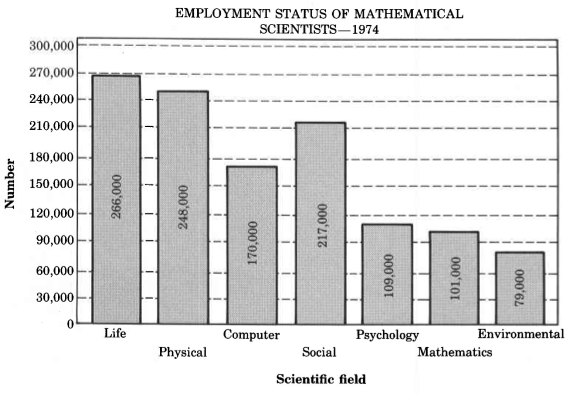
- Answer
-
1,190,000
Exercise \(\PageIndex{62}\)
Find the total number of sales for space vehicle systems for the years 1965-1980.

Exercise \(\PageIndex{63}\)
Find the total baseball attendance for the years 1960-1980.
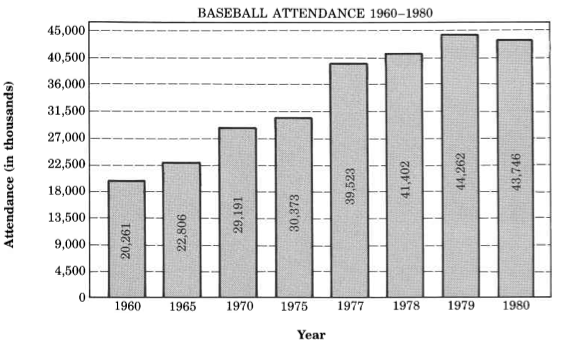
- Answer
-
271,564,000
Exercise \(\PageIndex{64}\)
Find the number of prosecutions of federal officials for 1970-1980.
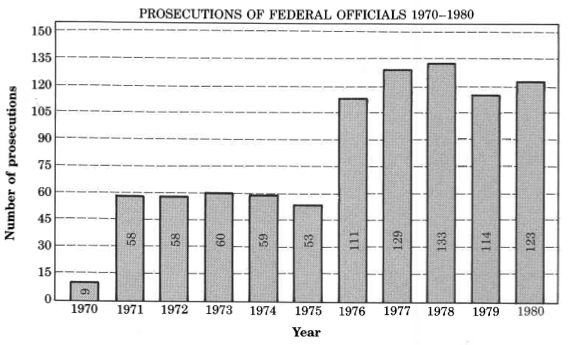
For the following problems, try to add the numbers mentally.
Exercise \(\PageIndex{65}\)
\(\begin{array} {r} {5} \\ {5} \\ {3} \\ {\underline{\ \ 7}} \end{array}\)
- Answer
-
20
Exercise \(\PageIndex{66}\)
\(\begin{array} {r} {8} \\ {2} \\ {6} \\ {\underline{\ \ 4}} \end{array}\)
Exercise \(\PageIndex{67}\)
\(\begin{array} {r} {9} \\ {1} \\ {8} \\ {5} \\ {\underline{\ \ 2}} \end{array}\)
- Answer
-
25
Exercise \(\PageIndex{68}\)
\(\begin{array} {r} {5} \\ {2} \\ {5} \\ {8} \\ {3} \\ {\underline{\ \ 7}} \end{array}\)
Exercise \(\PageIndex{69}\)
\(\begin{array} {r} {6} \\ {4} \\ {3} \\ {1} \\ {6} \\ {7} \\ {9} \\ {\underline{\ \ 4}} \end{array}\)
- Answer
-
40
Exercise \(\PageIndex{70}\)
\(\begin{array} {r} {20} \\ {\underline{\ \ 30}} \end{array}\)
Exercise \(\PageIndex{71}\)
\(\begin{array} {r} {15} \\ {\underline{\ \ 35}} \end{array}\)
- Answer
-
50
Exercise \(\PageIndex{72}\)
\(\begin{array} {r} {16} \\ {\underline{\ \ 14}} \end{array}\)
Exercise \(\PageIndex{73}\)
\(\begin{array} {r} {23} \\ {\underline{\ \ 27}} \end{array}\)
- Answer
-
50
Exercise \(\PageIndex{74}\)
\(\begin{array} {r} {82} \\ {\underline{\ \ 18}} \end{array}\)
Exercise \(\PageIndex{75}\)
\(\begin{array} {r} {36} \\ {\underline{\ \ 14}} \end{array}\)
- Answer
-
50
Exercises for Review (link)
Exercise \(\PageIndex{76}\)
Each period of numbers has its own name. From right to left, what is the name of the fourth period?
Exercise \(\PageIndex{77}\)
In the number 610,467, how many thousands are there?
- Answer
-
0
Exercise \(\PageIndex{78}\)
Write 8,840 as you would read it.
Exercise \(\PageIndex{79}\)
Round 6,842 to the nearest hundred.
- Answer
-
6,800
Exercise \(\PageIndex{80}\)
Round 431,046 to the nearest million.


